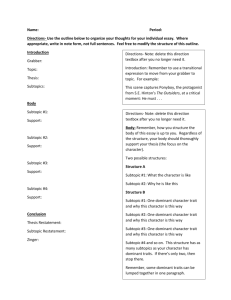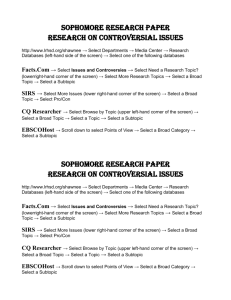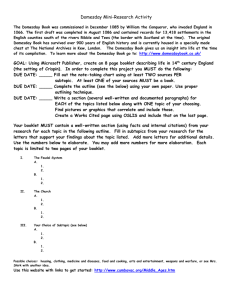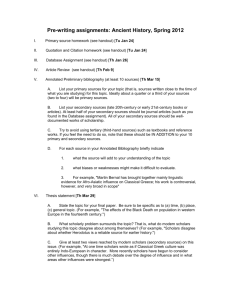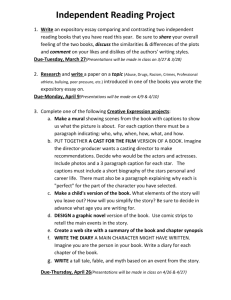BLOCK FORMAT OUTLINE for Nigeria Ibo Culture/American Culture
advertisement
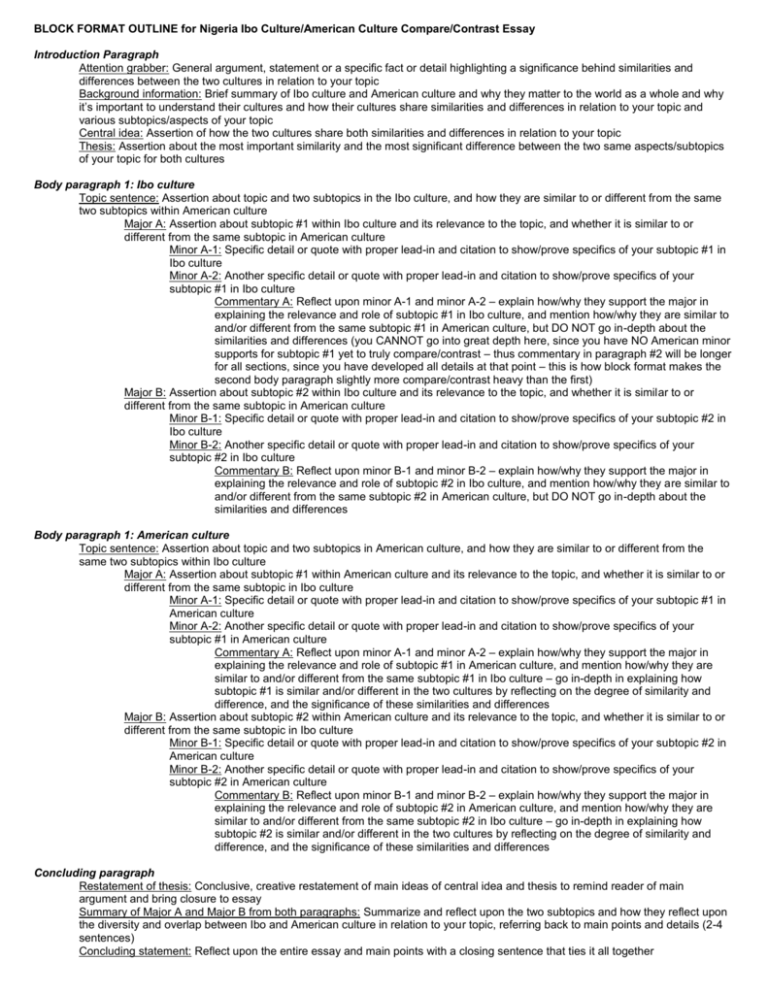
BLOCK FORMAT OUTLINE for Nigeria Ibo Culture/American Culture Compare/Contrast Essay Introduction Paragraph Attention grabber: General argument, statement or a specific fact or detail highlighting a significance behind similarities and differences between the two cultures in relation to your topic Background information: Brief summary of Ibo culture and American culture and why they matter to the world as a whole and why it’s important to understand their cultures and how their cultures share similarities and differences in relation to your topic and various subtopics/aspects of your topic Central idea: Assertion of how the two cultures share both similarities and differences in relation to your topic Thesis: Assertion about the most important similarity and the most significant difference between the two same aspects/subtopics of your topic for both cultures Body paragraph 1: Ibo culture Topic sentence: Assertion about topic and two subtopics in the Ibo culture, and how they are similar to or different from the same two subtopics within American culture Major A: Assertion about subtopic #1 within Ibo culture and its relevance to the topic, and whether it is similar to or different from the same subtopic in American culture Minor A-1: Specific detail or quote with proper lead-in and citation to show/prove specifics of your subtopic #1 in Ibo culture Minor A-2: Another specific detail or quote with proper lead-in and citation to show/prove specifics of your subtopic #1 in Ibo culture Commentary A: Reflect upon minor A-1 and minor A-2 – explain how/why they support the major in explaining the relevance and role of subtopic #1 in Ibo culture, and mention how/why they are similar to and/or different from the same subtopic #1 in American culture, but DO NOT go in-depth about the similarities and differences (you CANNOT go into great depth here, since you have NO American minor supports for subtopic #1 yet to truly compare/contrast – thus commentary in paragraph #2 will be longer for all sections, since you have developed all details at that point – this is how block format makes the second body paragraph slightly more compare/contrast heavy than the first) Major B: Assertion about subtopic #2 within Ibo culture and its relevance to the topic, and whether it is similar to or different from the same subtopic in American culture Minor B-1: Specific detail or quote with proper lead-in and citation to show/prove specifics of your subtopic #2 in Ibo culture Minor B-2: Another specific detail or quote with proper lead-in and citation to show/prove specifics of your subtopic #2 in Ibo culture Commentary B: Reflect upon minor B-1 and minor B-2 – explain how/why they support the major in explaining the relevance and role of subtopic #2 in Ibo culture, and mention how/why they are similar to and/or different from the same subtopic #2 in American culture, but DO NOT go in-depth about the similarities and differences Body paragraph 1: American culture Topic sentence: Assertion about topic and two subtopics in American culture, and how they are similar to or different from the same two subtopics within Ibo culture Major A: Assertion about subtopic #1 within American culture and its relevance to the topic, and whether it is similar to or different from the same subtopic in Ibo culture Minor A-1: Specific detail or quote with proper lead-in and citation to show/prove specifics of your subtopic #1 in American culture Minor A-2: Another specific detail or quote with proper lead-in and citation to show/prove specifics of your subtopic #1 in American culture Commentary A: Reflect upon minor A-1 and minor A-2 – explain how/why they support the major in explaining the relevance and role of subtopic #1 in American culture, and mention how/why they are similar to and/or different from the same subtopic #1 in Ibo culture – go in-depth in explaining how subtopic #1 is similar and/or different in the two cultures by reflecting on the degree of similarity and difference, and the significance of these similarities and differences Major B: Assertion about subtopic #2 within American culture and its relevance to the topic, and whether it is similar to or different from the same subtopic in Ibo culture Minor B-1: Specific detail or quote with proper lead-in and citation to show/prove specifics of your subtopic #2 in American culture Minor B-2: Another specific detail or quote with proper lead-in and citation to show/prove specifics of your subtopic #2 in American culture Commentary B: Reflect upon minor B-1 and minor B-2 – explain how/why they support the major in explaining the relevance and role of subtopic #2 in American culture, and mention how/why they are similar to and/or different from the same subtopic #2 in Ibo culture – go in-depth in explaining how subtopic #2 is similar and/or different in the two cultures by reflecting on the degree of similarity and difference, and the significance of these similarities and differences Concluding paragraph Restatement of thesis: Conclusive, creative restatement of main ideas of central idea and thesis to remind reader of main argument and bring closure to essay Summary of Major A and Major B from both paragraphs: Summarize and reflect upon the two subtopics and how they reflect upon the diversity and overlap between Ibo and American culture in relation to your topic, referring back to main points and details (2-4 sentences) Concluding statement: Reflect upon the entire essay and main points with a closing sentence that ties it all together Example essay [Attention grabber] Regardless of where people live in the world, all people must find a way to travel from one spot to another because no one can ever stay in the same location forever. [Background information] In both Nigeria and America, people must be able to move around in life, and the systems and methods used to get around are known as transportation systems. In Nigeria, the main means of transportation are bicycles and ox-drawn carts in the rural areas and small buses in the cities. In America, the main means of transportation are personal cars and public transportation via buses and trains. [Central/controlling idea] While there are similarities between the means of transportation in both Nigeria and America, there are also some key differences between how people get from place to place. [Thesis] The main similarities and differences between Nigerian transportation and American transportation revolve around the locations and distances people travel to and from and the means of transportation used. [Topic sentence] In Nigeria, the ways in which people travel are determined by where they live and how far they must travel and what means are available because Nigerian culture is very diverse throughout the country. [Major A] Locations and distances are the first main factors which determine how and where people travel in Nigeria. [Minor A-1] Nigeria is 95% rural and most people only travel on average "five miles or less per day" (Yearnston). [Minor A-2] In rural areas where people do not travel far all that is necessary are bikes and ox-carts, but in the few big cities citizens who travel over five miles can usually access a small bus (Norwen). Paved roads for buses have only been widespread in Nigeria for around fifteen years (Berton). [Commentary A] Due to the spread of rural areas compared to the limited spread of cities, most Nigerians still rely upon simple bikes and carts for small trips. These small trips are usually made by cars in America, but in American cities buses are also a common and convenient way to get around. [Major B] The three most common methods of transportation in Nigeria are bikes, ox carts, and small buses. [Minor B-1] Bikes and ox-carts are used in rural communities because "these vehicles require no gas or electricity and are easy to use and practical in farming communities" (Berton). In Things Fall Apart, bikes aren't introduced to the tribes if inner Nigeria until the late 1800s when white Christian missionaries arrive on bikes that the Ibo call an "iron horse" (Achebe 137). [Minor B-2] The small buses used in Nigerian cities "hold 8-12 passengers and are used by all people in cities for all purposes" (Yearnston). Even Nigerians living in cities tend not to own cars, so all Nigerians "use buses as taxis" (Norwen). [Commentary B] Bikes, ox carts, and buses are very practical for Nigerians depending upon an individual's location and needs. Americans use personal cars and bikes when traveling short distances and they also use buses in cities, but American cities also have subways and light rail systems in addition to buses. Also, when traveling long distances, most Americans prefer their personal cars, but many Nigerians do not own personal cars and because Nigeria is a smaller country cars are not as necessary for travel. [Concluding sentence] Bikes, ox carts, and buses make up the main means of Nigerian transportation because they are simple, convenient, and practical for the transportation needs of Nigeria. [Topic sentence] In the United States, transportation needs and habits are also determined by people's living arrangements, geography, and what transportation means citizens have available to them. [Major A] Locations and distances are a major factor in how Americans chose to travel. [Minor A-1] For instance, in rural America, “89% of all families own a truck” and “63% of all families own an SUV” (Grant). In suburban American, “72% of all families own an SUV and/or a minivan” (Grant). [Minor A-2] Americans who commute long distances typically own smaller sedans with better gas mileage for commuting, and those who live and and work in cities use public transportation on weekdays 92% of the work year (Lorrison). [Commentary A] Rural Americans own trucks and SUVs for working on their farms and dealing with harsher weather conditions and rugged terrain in the same way that Nigerians in rural areas use ox-carts as a practical means of both transportation and work. However, most Nigerians don’t have the luxury of personal vehicles, but they tend to live near where they work and live near their friends and families in small communities so the need for travel is greatly lessened. [Major B] The three most common methods of transportation in the United States are person cars, buses, and trains. [Minor B-1] Over 98% of American families own or lease at least one vehicle (Lorrison). [Minor B-2] In some suburban communities, commuter trains carry workers into major cities, while within major cities buses make up 81% of all public transportation and subways and light rail systems make up the other 19% (Grant). [Commentary] Personal vehicles and mass transportation systems make transportation more convenient in the United States as compared to transportation in Nigeria, however Nigeria neither has the wealth nor need for such widespread travel. In some ways, because of its cities and population, Nigeria’s system of buses as taxis can be seen as more convenient than buses and trains in American cities, and Nigerians share these buses as opposed to American taxi users who often travel alone. More and more Americans in cities are also riding bikes more often. [Concluding sentence] American transportation reflects the individualism and wealth of America as compared to the relative poverty and rural nature of Nigeria, while Nigerians only use what they need to get around in smaller ways and they are a more communal people. [Restate thesis] The differences between car ownership, rural living, and trains and bus systems and the similarities between needing practical vehicles in rural settings and trying to avoid gas consumption when possible for transportation reflect the main similarities and differences between Nigerian and American transportation cultures. [Highlight main points] These similarities and differences are reflective of distances traveled on average, geography, and available methods of transportation. Individual cars for Americans provide the same convenience over short distances as bikes provide for Nigerians over short distances while taxis in America compare to the small communal buses used in Nigerian cities. [Final analysis/overall commentary] Because Nigeria is more rural and poorer than the United States, it makes sense that they have fewer methods of transportation and need less, although they may benefit from some of the methods described. Therefore, it also makes sense that the United States has and needs more methods of transportation for their culture of commuting and spread-out, independent living. [Closing statement] Both cultures have similarities and differences in their transportation culture, yet both cultures travel according to needs, convenience, and ability and they manage to travel as best as possible in their unique cultures.

